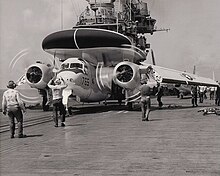Grumman E-1 Tracer
The E-1 Tracer was the first purpose built airborne early warning aircraft used by the United States Navy. It was a derivative of the C-1 Trader and first entered service in 1958. It was replaced by the more modern E-2 Hawkeye in the early 1970s.
Design and development
The E-1 was designated WF under the old US Navy system; the designation earned it the nickname "Willy Fudd". Since the S-2 Tracker was known as S2F under the old system, that airplane was nicknamed "Stoof"; the WF/E-1 with its distinctive radome gained the nickname "Stoof with a Roof."
Radar
The Tracer was fitted with the Hazeltine AN/APS-82 in its radome. The radar featured an Airborne Moving Target Indicator (AMTI), which analyzes the Doppler shift in reflected radar energy to distinguish a flying aircraft against the clutter produced by wave action at the ocean's surface. Separating a moving object from stationary background is accomplished by suitable hardware. See also Mercury Computer's explanation of AMTI, provided in the External Links below.
Variants

- XWF-1
- Design study for an Airborne Early Warning version of the S2F-1 Tracker, not built.
- WF-2
- Airborne Early Warning version of the TF-1 Trader, redesignated E-1B in 1962, 88 built.
- E-1B
- WF-2 redesignated in 1962.
Operators
Specifications


| This aircraft article is missing some (or all) of its specifications. If you have a source, you can help Wikipedia by adding them. |
General characteristics
- Crew: 4, two pilots, two RADAR/Intercept Controllers
Performance
Armament
none
See also
Related development
Aircraft of comparable role, configuration, and era
